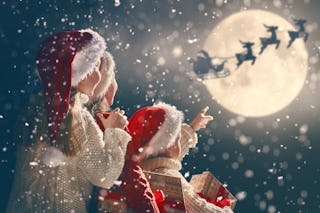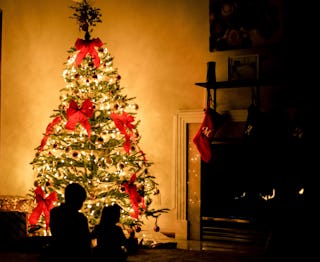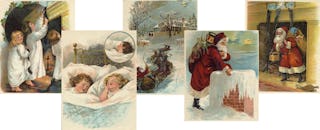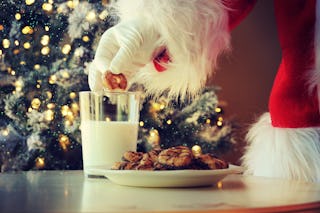
We’ve all heard the famous opening lines of this poem – “’Twas the night before Christmas, when all through the house…” It’s recited each year around the holidays and has sparked the imagination of children around the world!
But did you know that it’s also responsible for much of the Christmas imagery that we use today? Or that there’s a mystery that surrounds the author of the poem?
Check out the full version below and learn more about how it impacted the way we celebrate Christmas today!
A Visit From St. Nicholas
'Twas the night before Christmas, when all through the house
Not a creature was stirring, not even a mouse;
The stockings were hung by the chimney with care,
In hopes that St. Nicholas soon would be there;
The children were nestled all snug in their beds;
While visions of sugar-plums danced in their heads;
And mamma in her 'kerchief, and I in my cap,
Had just settled our brains for a long winter's nap,
When out on the lawn there arose such a clatter,
I sprang from my bed to see what was the matter.
Away to the window I flew like a flash,
Tore open the shutters and threw up the sash.
The moon on the breast of the new-fallen snow,
Gave a lustre of midday to objects below,
When what to my wondering eyes did appear,
But a miniature sleigh and eight tiny rein-deer,
With a little old driver so lively and quick,
I knew in a moment he must be St. Nick.
More rapid than eagles his coursers they came,
And he whistled, and shouted, and called them by name:
"Now, Dasher! now, Dancer! now Prancer and Vixen!
On, Comet! on, Cupid! on, Donner and Blitzen!
To the top of the porch! to the top of the wall!
Now dash away! dash away! dash away all!"
As leaves that before the wild hurricane fly,
When they meet with an obstacle, mount to the sky;
So up to the housetop the coursers they flew
With the sleigh full of toys, and St. Nicholas too—
And then, in a twinkling, I heard on the roof
The prancing and pawing of each little hoof.
As I drew in my head, and was turning around,
Down the chimney St. Nicholas came with a bound.
He was dressed all in fur, from his head to his foot,
And his clothes were all tarnished with ashes and soot;
A bundle of toys he had flung on his back,
And he looked like a pedler just opening his pack.
His eyes—how they twinkled! his dimples, how merry!
His cheeks were like roses, his nose like a cherry!
His droll little mouth was drawn up like a bow,
And the beard on his chin was as white as the snow;
The stump of a pipe he held tight in his teeth,
And the smoke, it encircled his head like a wreath;
He had a broad face and a little round belly
That shook when he laughed, like a bowl full of jelly.
He was chubby and plump, a right jolly old elf,
And I laughed when I saw him, in spite of myself;
A wink of his eye and a twist of his head
Soon gave me to know I had nothing to dread;
He spoke not a word, but went straight to his work,
And filled all the stockings; then turned with a jerk,
And laying his finger aside of his nose,
And giving a nod, up the chimney he rose;
He sprang to his sleigh, to his team gave a whistle,
And away they all flew like the down of a thistle.
But I heard him exclaim, ere he drove out of sight—
“Happy Christmas to all, and to all a good night!”

The History of the Poem
“A Visit from St. Nicholas”, also known as “The Night Before Christmas”, was published on December 23, 1823 with no name attached. It was sent in anonymously and no one would claim to be the author for more than a decade!
At the time of publication, Christmas had, well, a pretty bad reputation. It had become associated with disorderly parties and some religious groups even called for the abolishment of the holiday! It wasn’t associated with families and Santa was thought to dole out punishments rather than gifts. But “A Visit from St. Nicholas”’ portrayal of jolly Old St. Nick and the delivery of presents to children all over the world changed the entire picture of Christmas.

13 years after its publication, Clement Clark Moore, a professor and poet, claimed that he wrote the original poem. He said that he composed the poem years earlier for his children and read it to them every year around the holidays. His housekeeper mailed it into the newspaper, unbeknownst to Moore, insisting that such a wonderful picture of Christmas be exposed to the world.
It seems pretty reasonable, doesn’t it?
But then, the family of a man named Henry Livingston, Jr. claimed that he had been reciting the exact same poem to them 15 years before it was even published. They pointed out that Livingston was Dutch and, since many of the elements of the poem originated from Dutch language and traditions (like the names of the reindeer), he must be the author. Experts also say that the style of poetry is much closer to that of Livingston’s rather than Moore’s.
But Moore was a good friend of Washington Irving, who used the same type of imagery and language in his famous writing, “A History of New York”. Irving is thought to have been the originator of the Santa imagery that we use today. And, of course, this would also explain the Dutch references (Irving was Dutch).
Regardless of the controversy, Moore is widely considered to be the author.

The Impact of “A Visit From St. Nicholas”
“A Visit from St. Nicholas” came to define Christmas in a lot of ways. It made popular much of the Christmas imagery that we use today, like 8 flying reindeer (and their names), the jolly, fat man that is our beloved Santa Claus, the idea of Santa going down the chimney, and much more.
While some of the ideas were borrowed from Irving (like the idea of Santa in a sleigh and his rotund appearance), it was the first appearance of reindeer in the mythology and made the “holly jolly” association with Christmas popular.
The poem was also the inspiration for Thomas Nast’s famous illustrations in Harper’s Illustrated and Coca Cola’s world-renowned Santa commercials.
Fun Fact: The names Donner and Blitzen mean “thunder” and “lightning”.